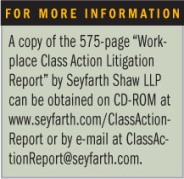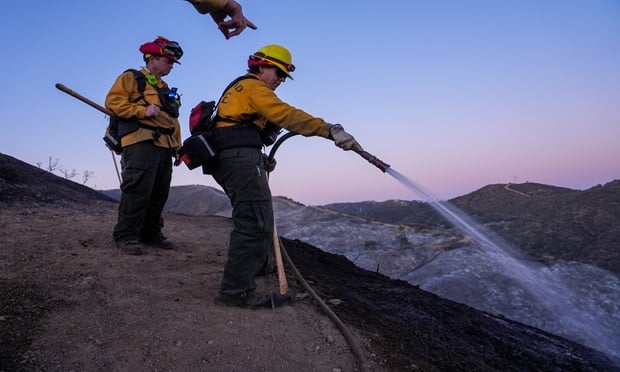Employers are likely to face more claims and bigger exposures in 2010 as sophisticated class actions and collective lawsuits increase along with aggressive government enforcement, one leading law firm predicted.
 Those and other findings were part of the sixth annual “Workplace Class Action Litigation Report” by Seyfarth Shaw LLP, analyzing class-action and collective action court rulings of 2009 involving claims against employers in federal and state courts.
Those and other findings were part of the sixth annual “Workplace Class Action Litigation Report” by Seyfarth Shaw LLP, analyzing class-action and collective action court rulings of 2009 involving claims against employers in federal and state courts.
“Since we began publishing this annual report six years ago, both the number of cases filed and the financial exposure that they pose to companies has increased exponentially,” J. Stephen Poor, chair and managing partner of Seyfarth Shaw, said in a statement.
“As plaintiffs' attorneys bring increasingly sophisticated litigation against employers that combine claims under multiple statutes, the financial exposure is only going to become greater for businesses,” Mr. Poor warned.
The report's general editor, Gerald L. Maatman Jr.–co-chair of the firm's Complex Discrimination Litigation Practice Group and frequent columnist for National Underwriter–said a significant number of the firm's attorneys contributed to the study.
“One certain conclusion drawn from this year's report is that employment law class-action and collective action litigation is becoming ever more sophisticated, and will continue to be a source of significant financial exposure to employers well into the future,” Mr. Maatman said.
The report examines class-action and collective action settlements over the past year, in terms of gross settlement dollars in private-plaintiff and government-initiated lawsuits, and injunctive relief provisions in consent decrees. It analyzes 715 class-action litigation rulings.
Perhaps the most noteworthy ruling in 2009, according to the report, is the defense-oriented decision in Vinole v. Countrywide Home Loans, Inc., 571 F.3d 935 (9th Circuit 2009), a large wage-and-hour class action.
The 9th U.S. Circuit Court of Appeals held that a defendant is entitled to bring a motion seeking a determination that a class action should not be certified. Vinole, according to the firm,is the first federal circuit decision to squarely address this procedural issue.
The significance of the circuit court's ruling will most likely be seen in the coming years, as defense counsel craft strategies to attack a plaintiff's class-action theories in the proactive manner endorsed by Vinole, the report said.
According to the report, the private plaintiff-initiated monetary settlements and government-initiated monetary settlements in class-action settlements for 2009 involved:
o Employment Discrimination: The monetary value of the top-10 private plaintiff settlements entered into or paid in 2009 totaled $86.2 million. This represented a slight drop from the last two years. By comparison, the top-10 settlements in 2008 totaled $118.36 million.
o Wage and Hour: The monetary value of the top-10 private settlements entered into or paid in 2009 totaled $363.6 million–up significantly from the top-10 settlements in 2008, which totaled $252.7 million.
o ERISA: The monetary value of the top-10 private settlements entered into or paid in 2009 involving Employee Retirement Income Security Act cases totaled $499.5 million–down significantly from 2008, when the total monetary value of the top-10 private settlements reached $17.7 billion.
o EEOC: Based on preliminary figures for the U.S. government's 2009 fiscal year, the Equal Employment Opportunity Commission filed 281 new lawsuits, resolved 319 pending lawsuits, and secured $294.1 million in settlements for allegedly injured victims of job bias.
As of Sept. 30, 2009 (the end of the U.S. government's fiscal year), 39 commissioners' charges were being investigated, compared with 15 commissioners' charges in April 2006–the month before the EEOC established its systemic discrimination program.
In addition, the EEOC's docket of systemic, pattern or practice cases more than doubled over fiscal year 2008. For all types of government-initiated enforcement actions, the monetary value of the top-10 settlements entered into or paid in 2009 totaled $107.1 million.
This was a significant increase over 2008, when the top-10 settlements totaled $85.03 million.
Want to continue reading?
Become a Free PropertyCasualty360 Digital Reader
Your access to unlimited PropertyCasualty360 content isn’t changing.
Once you are an ALM digital member, you’ll receive:
- Breaking insurance news and analysis, on-site and via our newsletters and custom alerts
- Weekly Insurance Speak podcast featuring exclusive interviews with industry leaders
- Educational webcasts, white papers, and ebooks from industry thought leaders
- Critical converage of the employee benefits and financial advisory markets on our other ALM sites, BenefitsPRO and ThinkAdvisor
Already have an account? Sign In Now
© 2025 ALM Global, LLC, All Rights Reserved. Request academic re-use from www.copyright.com. All other uses, submit a request to [email protected]. For more information visit Asset & Logo Licensing.








